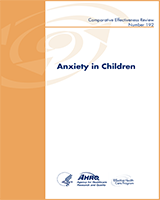NCBI Bookshelf. A service of the National Library of Medicine, National Institutes of Health.
Wang Z, Whiteside S, Sim L, et al. Anxiety in Children [Internet]. Rockville (MD): Agency for Healthcare Research and Quality (US); 2017 Aug. (Comparative Effectiveness Reviews, No. 192.)
Table C.1Inclusion and exclusion criteria
| PICOTS Elements | Inclusion Criteria | Exclusion Criteria |
|---|---|---|
| Populations | Humans Children and adolescents between 3 and 18 years old Patients with confirmed diagnosis of panic disorder, social anxiety disorder, specific phobias, generalized anxiety disorder, or separation anxiety | Animals Adults (age >= 18 years) Infants (age < 3 years) Patients without confirmed diagnosis of panic disorder, social anxiety disorder, specific phobias, generalized anxiety disorder, or separation anxiety |
| Interventions | Any psychotherapy, pharmacotherapy, alone or combined: Pharmacological treatments will include all formulations of: Selective reuptake inhibitor (SRI): Citalopram (Celexa), Escitalopram (Lexapro), Fluoxetine (Prozac), Fluvoxamine (Luvox), Paroxetine (Paxil), Sertraline (Zoloft) Serotonin-norepinephrine reuptake inhibitors (SNRI): Desvenlafaxine (Pristiq), Duloxetine (Cymbalta), Venlafaxine (Effexor) Tricyclic antidepressants (TCA): Amiptriptyline or Nortriptyline (Elavil or Aventyl HCI), Clomipramine (Anafranil) Benzodiazepines: Alprazolam (Xanax, Niravam), Clonazepam (Klonopin), Lorazepam (Ativan) Atypical Antipsychotics: Aripiprazole (Abilify), Olanzapine (Zyprexa Zydis), Quetiapine (Seroquel), Risperidone (Risperdal), Ziprasidone (Geodon, Zeldox, or Zipwell) Monoamine oxidase inhibitor: Phenelzine (Nardil) Others: Bupropion (Wellbutrin), Mirtazapine (Remeron), D-Cycloserine (Seromycin), N-Acetylcysteine, Methylphenidate (Ritalin, Daytrana, Concerta, Methylin, or Aptensio), Riluzole (Rilutek), Buspirone (Buspar), Propranolol (Inderal, Hemangeol, or Innopran), Prazosin (Minipress), Cyproheptadine (Periactin or Peritol), Carbamazepine (Tegretol, Carbatrol, Equetro, or Epitol), Divalproex (Alti-Valproic, Depakote, Depakote DR, Depakote ER, or Depakote Sprinkles) Psychotherapies: Cognitive and behavioral therapies (CBT) Exposure Therapy/Systematic Desensitization Contingency Management Exposure Therapy Self-Control Exposure Therapy Family Focused Cognitive Behavior Therapy Child Focused Cognitive Behavior Therapy Parent Child Interaction Therapy Problem solving therapy (PST) Third wave (Mindfulness) therapies Acceptance and Commitment Therapy Mindfulness Based Cognitive Therapy/Mindfulness Based Stress Reduction Psychodynamic psychotherapy Interpersonal psychotherapy (IPT) Play therapy Family therapy Behavioral Systems Family therapy Narrative Family Therapy Solution Focused Family Therapy Strategic Family Therapy Attention modification program Motivational interviewing Eye movement desensitization reprocessing therapy (EMDR) Complementary psychotherapy techniques Exercise Biofeedback Relaxation Therapies Progressive muscle relaxation Diaphramatic breathing Visualization Meditation techniques Hypnosis Or any combined of the listed treatment | None |
| Comparators | Other treatment or no treatment | None |
| Outcomes | KQ 1: Intermediate outcomes: Standardized measures (child, parent, school, and clinician report) such as the Screen for Anxiety-Related Emotional Disorders (SCARED), the Revised Children’s Manifest Anxiety Scale (RCMAS), the Beck Anxiety Inventory, the Multidimensional Anxiety Scale for Children (MASC), the Liebowitz Social Anxiety Scale, the Social Phobia and Anxiety Inventory for Children, the Spence Children’s Anxiety Scale (child and parent report) (SCAS), Fear Survey Schedule for Children – Revised, Stait Trait Anxiety Inventory - Child (STAIC), Anxiety Disorder Interview Schedule - Child report, Pediatric Anxiety Rating Scale (PARS), Child Behavior Checklist (CBCL), Revised Child Anxiety and Depression Scale (RCADS), Pre-School Anxiety Scale, Clinical Global Impression Scale (CGI), Children’s Anxiety Meter-State (CAM-S) Patient centered outcomes: Remission, relapse, anxiety symptoms, behavioral problems (Behavior Assessment System for Children, Achenbach Child Behavior Checklist), parental overprotection, accommodation, parent distress, therapeutic alliance, school attendance, reduction in impairment (Child Sheehan Disability Scale), quality of life (Multidimensional Child Health Questionnaire, and Youth Quality of Life Instrument – Research Version), avoiding hospitalization, length of treatment, availability of treatment, peer relationship, functional impairment (Child Anxiety Impact Scale (CAIS), Children’s Global Assessment Scale (CGAS), and Child Anxiety Life Interference Scale (CALIS)), avoidance behavior in children. KQ 2: Safety outcomes such as incidence of any adverse events, GI adverse effects/discomfort, withdrawal symptoms, dropouts due to adverse events, neurological complaints, increase motor activity, suicidal ideation, homicidal behavior, treatment emergent suicidality, addiction, self-injurious behaviors, activation issues (e.g. sleep, motor activity), agitation, akathisia, mania, aggression, and psychosis. | None |
| Timing | Any | None |
| Settings | Any | None |
| Study design | Original data Any sample size RCTs, nonrandomized comparative studies (prospective and retrospective) Relevant systematic reviews, or meta-analyses (used for identifying additional studies) | In vitro studies Non-original data (e.g. narrative reviews, editorials, letters, or erratum) Non-comparative observational studies, case series |
| Publications | Any | None |
KQ = key question; PICOTS = populations, interventions, comparators, outcomes, timing, and settings; RCT = randomized controlled trial
- Criteria for Inclusion/Exclusion of Studies - Anxiety in ChildrenCriteria for Inclusion/Exclusion of Studies - Anxiety in Children
Your browsing activity is empty.
Activity recording is turned off.
See more...
